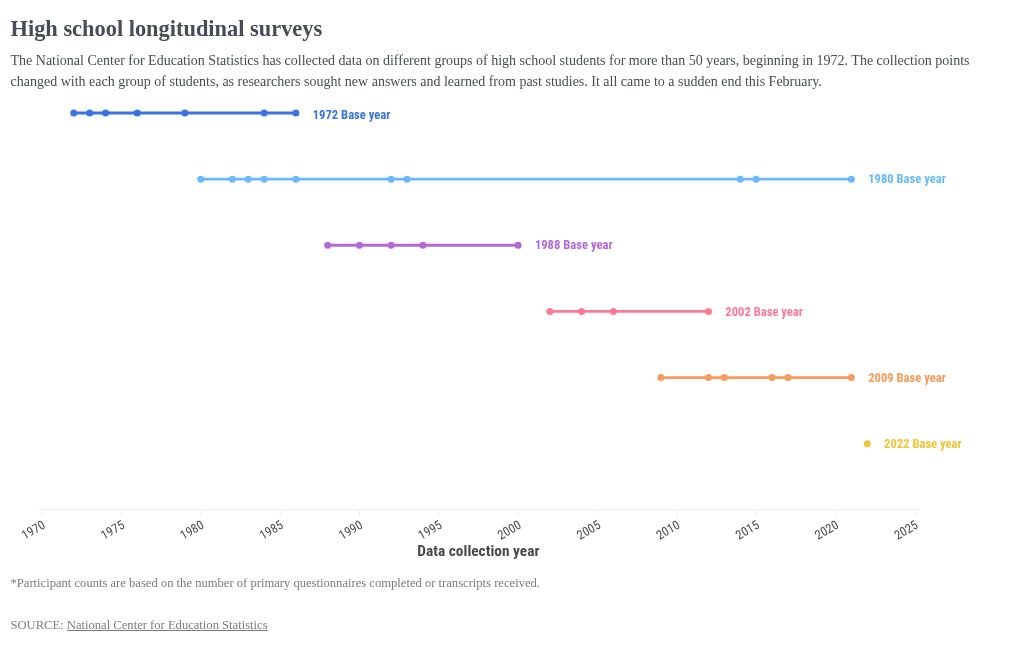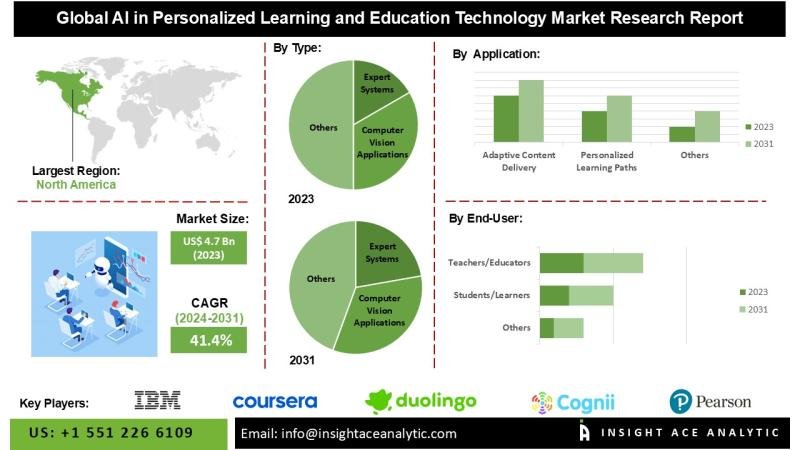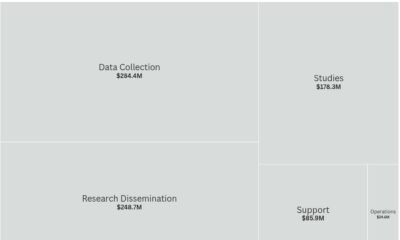Education
A window into America’s high schools slams shut

This story was reported by and originally published by APM Reports in connection with its podcast Sold a Story: How Teach Kids to Read Went So Wrong.
The choices you make as a teenager can shape the rest of your life. If you take high school classes for college credit, you’re more likely to enroll at a university. If you take at least 12 credits of classes during your first year there, you’re more likely to graduate. And those decisions may even influence whether you develop dementia during your later years.
These and insights from thousands of other studies can all be traced to a trove of data that the federal government started collecting more than 50 years ago. Now that effort is over.
On a single day in February, the Trump administration and its Department of Government Efficiency canceled a long-running series of surveys called the high school longitudinal studies. The surveys started in 1972, and they had gathered data on more than 135,000 high school students through their first decade or so of adulthood — sometimes longer.
“For 50 years, we’ve been mapping a timeline of progress of our high school system, and we’re going to have a big blank,” said Adam Gamoran, who leads the William T. Grant Foundation and was nominated to head up the Education Department’s research and statistics arm under President Biden, but was never confirmed. “That’s very frustrating.”
The data collection effort has been going on since before the founding of the modern Department of Education. Thousands of journal articles, books, dissertations and reports have relied on this data to form conclusions about American education — everything from how high school counselors should be spending their days to when students should start taking higher-level math classes.
The Department of Government Efficiency first canceled contracts for the collection of new long-term high school data and then started laying off staff. The National Center for Education Statistics used to have nearly 100 employees. Today, only three remain.
“The reduction — annihilation — of NCES functionally is a very serious issue,” said Felice Levine, former executive director of the American Educational Research Association, one of the groups suing the administration over these actions. “Maybe it doesn’t appear to be as sexy as other topics, but it really is the backbone of knowledge building and policymaking.”
The Department of Education is reviewing how longitudinal studies “fit into the national data collection strategy based on studies’ return on investment for taxpayers,” according to an email from its spokesperson. The statement also said the department’s Institute of Education Sciences, which is in charge of overseeing research and gathering statistics, remains committed to “mission-critical functions.”
“It seems to me that even if you were the most hardcore libertarian who wants the government to regulate almost nothing, collecting national statistics is about the most innocuous and useful thing that a government could do,” said Stuart Buck, executive director of the Good Science Project, a group advocating less bureaucracy in science funding.
“The idea of a Department of Governmental Efficiency is an excellent idea, and I hope we try it out sometime,” he said. But the effort, “as it currently exists, I would argue, is often directly opposed to efficiency. Like, they’re doing the exact opposite.”
He likened the approach to “someone showing up to your house and claiming they saved you $200 a month, and it turns out they canceled your electricity.”
Related: Become a lifelong learner. Subscribe to our free weekly newsletter featuring the most important stories in education.
Since the effort began in the early 1970s, the federal government has collected data on six large groups of high school students, each numbering in the tens of thousands. Researchers surveyed each group at least once during high school, along with their parents and teachers. Researchers then contacted the students periodically after that, generally over the course of a decade or so — sometimes longer. They collected transcripts and other documents to track progress, too. In total, the data set contains thousands of variables.
The studies are called longitudinal, because they take place over a long time. The methodology is similar to studies that track twins over their lifetimes to determine which traits are genetic and which are caused by their experiences. Such data sets are valuable because they allow researchers to tease out effects that can’t be seen in a single snapshot, but they are rare because they require sustained funding over decades. And the high school data covers a large number of participants selected to represent the national population, giving insights that can be broadly applicable across states.
That vast repository of data affects students “indirectly, but profoundly,” said Andrew Byrne, who runs the math department at Greenwich High School in Connecticut. For example, research based on the data has shown that high school students who take classes for college credit have a better chance of finishing their bachelor’s degrees on time.
Byrne said that research informed the school’s decision to start offering a new Advanced Placement precalculus class when the College Board unveiled it two years ago. The new offering gave some high school students in lower-level math classes the opportunity to get college credit for the first time.
“Success in AP precalculus could empower them to believe they can succeed in college-level classes overall,” Byrne said. A student probably would not read the academic research, but “they live the results of the decisions that data informs,” he said.
Follow-up surveys for the group first contacted in 2009 — made up of people who started high school during the Great Recession — and for students who were high school freshmen in 2022 have been canceled. The latter group, who were middle schoolers during the pandemic, will be graduating next year.
Elise Christopher oversaw the high school longitudinal studies at the National Center for Education Statistics until she was laid off in March along with dozens of her colleagues. Christopher, a statistician who worked at the center for more than 14 years, is concerned about the data that was scheduled to be collected this year — and now won’t be.
“We can’t just pick this back up later,” she said. “They won’t be in high school. We won’t be able to understand what makes them want to come to school every day, because they’ll be gone.”
Researchers were hoping to learn more about why chronic absenteeism has persisted in schools even years after Covid-19 abated, Christopher explained. They were also hoping to understand whether students are now less interested in attending college than previous generations.
“Every single person in this country who’s been educated in the past 50 years has benefited from something that one of these longitudinal surveys has done,” she said.
Levine said the planned follow-up with students from the 2009 high school group would have helped reveal how a greater emphasis on math, science and technology in some states has influenced student decision-making. Were they more likely to study the hard sciences in college? Did they continue on to careers in those fields?
“These are the kinds of things that the public wants to know about, families want to know about, and school administrators and counselors want to know about,” she said.
Related: Suddenly sacked
About 25,000 people who completed the high school survey in 1980 were contacted again by researchers decades later.
Rob Warren, the director of the University of Minnesota’s Institute for Social Research and Data Innovation, is hoping those people — now in their 60s — may help him and other researchers gain new insights into why some people develop dementia, while others with similar brain chemistry don’t.
“Education apparently plays a big role in who’s resilient,” Warren said. “That’s kind of a mystery.”
The people who participated in the high school study may offer a unique set of clues about why education matters, Warren explained.
“You need all that detail about education, and you need to be able to see them decades later, when they’re old enough to start having memory decline,” he said. Other studies can measure cognition, but to measure whether education plays a role in dementia outcomes, “you can’t really test (that) with other data,” he said.
So Warren’s team got permission from the federal government to contact the group in 2019. Researchers asked all the usual types of questions about their jobs and lives, but also gave them cognitive tests, asked medical questions, and even collected samples of their blood to monitor how their brains were changing as they aged.
Warren is continuing his research even though the federal government has canceled future high school surveys. But the staffing cuts at the Department of Education have hampered his ability to hand the data off to the center or share it with other researchers. To do that, he needs permission from the Department of Education, but getting it has been a challenge
“Very often you don’t hear anything back, ever, and sometimes you do, but it takes a very long time,” Warren said. Even drafting legal agreements to make the data available to the National Institutes of Health — another federal agency, which funded his data collection effort and would be responsible for handling the medical data — has been a bottleneck.
Such agreements would involve a bunch of lawyers, Warren said, and the Department of Education has laid off most of its legal team.
If the data isn’t made available to other researchers, Warren said, questions about dementia may go unanswered and “NIH’s large investment in this project will be wasted.”
Kate Martin contributed to this report.
Education
Kent and Greenwich universities to merge in attempt to improve financial viability | Higher education

The universities of Kent and Greenwich are set to merge in an attempt to improve their financial viability against a backdrop of economic turmoil across higher education in the UK.
Under the proposed name of London and South East University Group, the single institution will have one vice-chancellor from the academic year starting in autumn 2026. The two universities combined will have 28,000 first degree undergraduates, according to the Higher Education Statistics Agency.
The universities said the combined institution would provide a stronger financial foundation to overcome the economic challenges facing universities now and in the future.
The Office for Students (OfS), England’s higher education regulator,welcomed the move and suggested that more universities may explore similar options as their income has fallen for the third year in a row.
This is due to falls in international students after immigration and visa changes as well as the declining real-terms value of the tuition fee paid by UK students, with the result that 40% of English universities are now believed to be in financial deficit.
The Department for Education (DfE) said ministers “welcome innovative approaches such as this one”.
The vice-chancellors of both universities told the BBC that the move was not a takeover by either institution, although they added that the new university model would be “resilient and financially viable”.
The new university will operate across the existing campuses, including in Medway, where students from both Greenwich and Kent already share the library and other facilities.
Kent has one other campus, in Canterbury, about 48km from Medway, while Greenwich has two other campuses, one on the banks of the River Thames in Greenwich – itself about 45km from Medway – and the other in Avery Hill, south-east London, about 38km away.
Many institutions have been trying to repair budget deficits by slashing building and maintenance spending as well as cutting courses and staff, with the sector expected to sell off more than £400m worth of land and property this year.
Prof Georgina Randsley de Moura will remain the interim leader of Kent until the merger, when Prof Jane Harrington, who runs Greenwich, will become the vice-chancellor of the new institution.
Prof Randsley de Moura said the “trailblazing model” would enable the universities within the new group to retain their name, identity and campuses.
Students will be unaffected by the change, with applications continuing as normal to each institution and degrees awarded in the name of Kent or Greenwich.
Prof Harrington said the universities had worked together on the Medway campus for 20 years and now wanted to contribute more to the economy across London and the south-east.
She added that students would “absolutely categorically” be able to complete any course they are already enrolled on, including those starting university this autumn.
The universities said there are no immediate plans for job losses. Prof Harrington said that costs would be saved by reducing senior roles.
In May, Greenwich confirmed it was cutting the equivalent of 15 full-time posts by August. Kent has already started winding down some courses to reduce costs after posting a deficit for another year in 2024.
Across England, job losses at many institutions over the last couple of years have been mounting, with the University and College Union (UCU) estimating the overall number of posts cut at about 5,000.
Mergers were previously rare but have now become more common, with City St George’s created from two separate University of London universities last year, although most others have involved smaller or specialist institutions.
The OfS chair, Edward Peck, said: “The OfS’s financial sustainability analysis has starkly demonstrated the challenges facing the sector. More universities taking steps to ensure their long-term financial future will likely explore the possibility of working more closely with partners, up to and including mergers. While the OfS will consider any regulatory decisions in this case carefully and on their merits, these initial proposals are to be welcomed.”
A Department for Education spokesperson said: “This collaboration shows how strong partnerships in higher education can help enable delivery of world-class teaching and research while maintaining the best interests of students.
“Through our Plan for Change we are committed to fixing the foundations of higher education, and we will soon publish our plans for HE reform as part of the post-16 education and skills strategy white paper.”
Education
AI in Personalized Learning and Education Technology Market Set

InsightAce Analytic Pvt. Ltd. announces the release of a market assessment report on the “Global AI in Personalized Learning and Education Technology Market – (By Type (Machine Learning Algorithms, Natural Language Processing (NLP) Systems, Expert Systems, Computer Vision Applications, Intelligent Tutoring Systems (ITS), Virtual Learning Environments (VLEs), Adaptive Learning Platforms), By Application (Adaptive Content Delivery, Personalized Learning Paths, Individualized Assessment and Feedback, Intelligent Content Creation, Smart Content Recommendations, Personalized Learning Analytics, Student Progress Monitoring), By Educational Level (K-12 Education, Higher Education (Colleges and Universities), Corporate Training and Professional Development, Language Learning, Skill-based Learning), By End-User (Students/Learners, Teachers/Educators, Administrators/Schools and Institutions, Corporations and Enterprises, Language Learning Institutions)), Trends, Industry Competition Analysis, Revenue and Forecast To 2034.”
According to the latest research by InsightAce Analytic, the Global AI in Personalized Learning and Education Technology Market is valued at USD 6.5 Bn in 2024, and it is expected to reach USD 208.2 Bn by the year 2034, with a CAGR of 41.4% during the forecast period of 2025-2034.
Get Free Access to Demo Report, Excel Pivot and ToC: https://www.insightaceanalytic.com/request-sample/2692
Artificial Intelligence (AI) is increasingly being integrated into personalized learning and educational technology, driving a transformative shift in traditional teaching methodologies. AI-powered personalized learning leverages data-driven algorithms to evaluate various aspects of student performance, learning preferences, and progression, enabling the creation of customized curricula and targeted interventions. This approach allows educators to develop adaptive learning pathways that align with each student’s unique strengths and areas for improvement, fostering a more engaging and effective educational experience.
Effective learner segmentation is critical to the successful deployment of AI in personalized education. By classifying students based on attributes such as learning styles, academic performance, and areas of interest, educators can deliver tailored content and interventions that address specific learning needs. This individualized approach enhances engagement and supports deeper comprehension of complex concepts, thereby contributing to improved learning outcomes.
AI systems can analyze large volumes of data to identify patterns and trends, facilitating the development of precise segmentation strategies. Machine learning models further augment this capability by integrating data from multiple sources-including assessments, quizzes, and peer interactions-providing a holistic understanding of each student’s learning trajectory.
List of Prominent Players in the AI in Personalized Learning and Education Technology Market:
• Coursera
• Duolingo
• Khan Academy
• IBM Watson Education
• Blackboard
• Cognii
• Knewton
• Pearson
• Squirrel Al Learning
• Content Technologies, Inc.
• Third Space Learning
• ALEKS (Assessment and Learning in Knowledge Spaces)
Expert Knowledge, Just a Click Away: https://calendly.com/insightaceanalytic/30min?month=2025-03
Market Dynamics
Drivers:
The rising demand for personalized learning experiences tailored to students’ diverse needs and learning paces is a key driver of the AI in education market. AI-powered platforms, including adaptive learning systems, enable the analysis of student data to deliver customized educational content, thereby enhancing overall learning outcomes. The rapid expansion of remote and hybrid learning models has further accelerated AI adoption by facilitating more interactive and efficient virtual classrooms.
Widespread access to digital devices and reliable internet connectivity supports the seamless integration of AI solutions into educational environments. Additionally, the growing emphasis on data-driven insights to inform instructional strategies and policy-making contributes to market growth, as AI provides actionable analytics and feedback to educators and administrators.
Challenges:
The AI in education market faces several challenges, including concerns around data privacy and security, particularly the protection of sensitive student information. Integrating AI solutions with existing educational infrastructure can be complex, which may impede smooth adoption. High implementation and maintenance costs can limit deployment, especially for institutions with constrained budgets.
Other barriers include the lack of standardized curricula, insufficient educator training, and the digital divide, which results in unequal access to technology. Ethical considerations, such as algorithmic bias and AI-driven decision-making, also require careful management to ensure equitable learning outcomes.
Regional Trends:
North America is expected to lead the global AI in personalized learning market, driven by advanced technological infrastructure, substantial investment in educational technology, and widespread adoption of AI-enabled solutions across K-12 and higher education. Europe is projected to capture a significant market share, supported by progressive educational reforms, increased funding for edtech initiatives, and a strong focus on personalized learning to enhance student performance.
Collaborative efforts between educational institutions and technology providers in Europe are further fostering innovation in AI-based solutions, enabling tailored learning experiences that address diverse student needs and improve engagement.
Unlock Your GTM Strategy: https://www.insightaceanalytic.com/customisation/2692
Recent Developments:
• In May 2024, Khan Academy and Microsoft collaborated to enhance the availability of AI tools that customized instruction and facilitated enjoyable learning experiences. Microsoft provided Khan Academy with free access to the pilot of Khanmigo for Teachers by donating access to Azure AI-optimized infrastructure, allowing all K-12 educators in the U.S. to benefit from this service at no cost. Consequently, Khanmigo for Teachers is currently being operated by Azure OpenAI Service.
• In Jan 2024, Coursera has introduced new artificial intelligence (AI) functionalities to cater to the requirements of learners in India. There are currently more than 4,000 courses offered in the Hindi language. Furthermore, Coursera has revealed its acquisition of new industry and campus clients, as educational institutions throughout India have enthusiastically adopted online learning to provide their employees and students with essential digital competencies.
Segmentation of AI in Personalized Learning and Education Technology Market-
AI in Personalized Learning and Education Technology Market By Type:
• Machine Learning Algorithms
• Natural Language Processing (NLP) Systems
• Expert Systems
• Computer Vision Applications
• Intelligent Tutoring Systems (ITS)
• Virtual Learning Environments (VLEs)
• Adaptive Learning Platforms
AI in Personalized Learning and Education Technology Market By Application:
• Adaptive Content Delivery
• Personalized Learning Paths
• Individualized Assessment and Feedback
• Intelligent Content Creation
• Smart Content Recommendations
• Personalized Learning Analytics
• Student Progress Monitoring
AI in Personalized Learning and Education Technology Market By Educational Level:
• K-12 Education
• Higher Education (Colleges and Universities)
• Corporate Training and Professional Development
• Language Learning
• Skill-based Learning
AI in Personalized Learning and Education Technology Market By End-User:
• Students/Learners
• Teachers/Educators
• Administrators/Schools and Institutions
• Corporations and Enterprises
• Language Learning Institutions
AI in Personalized Learning and Education Technology Market By Region-
North America-
• The US
• Canada
• Mexico
Europe-
• Germany
• The UK
• France
• Italy
• Spain
• Rest of Europe
Asia-Pacific-
• China
• Japan
• India
• South Korea
• South East Asia
• Rest of Asia Pacific
Latin America-
• Brazil
• Argentina
• Rest of Latin America
Middle East & Africa-
• GCC Countries
• South Africa
• Rest of Middle East and Africa
Read Overview Report- https://www.insightaceanalytic.com/report/ai-in-personalized-learning-and-education-technology-market/2692
About Us:
InsightAce Analytic is a market research and consulting firm that enables clients to make strategic decisions. Our qualitative and quantitative market intelligence solutions inform the need for market and competitive intelligence to expand businesses. We help clients gain competitive advantage by identifying untapped markets, exploring new and competing technologies, segmenting potential markets and repositioning products. Our expertise is in providing syndicated and custom market intelligence reports with an in-depth analysis with key market insights in a timely and cost-effective manner.
Contact us:
InsightAce Analytic Pvt. Ltd.
Visit: www.insightaceanalytic.com
Tel : +1 607 400-7072
Asia: +91 79 72967118
info@insightaceanalytic.com
This release was published on openPR.
Education
Let’s reshape the liberal arts with a focus on applied learning, internships and training for jobs of the future and let faculty lead the way

Today’s colleges face an uncertain future and need to be more relevant and more connected to the world of work to thrive.
The liberal arts, which have evolved throughout history to meet the needs of society and the state of knowledge, were created for the industrial era. They are badly dated and must be rethought to prepare students for the global, digital, knowledge economy in which they will live their lives.
Vocational education prepares people for their next job. But liberal arts education is designed to do more — to “future-proof” students. By helping students learn to solve problems and think critically, the liberal arts prepare students not for their next job but for jobs that don’t exist. And with the world changing rapidly, with new technologies replacing many jobs and employers demanding proof of skills, the liberal arts need to be future-proofed themselves.
Related: Interested in innovations in higher education? Subscribe to our free biweekly higher education newsletter.
The liberal arts are most successful when they have one foot in the library (the accumulated knowledge of humanity) and one foot in the street (the real world of the marketplace, politics and social interaction), to paraphrase the social reformer Jane Addams.
These are times of rapid change. We are simultaneously experiencing demographic, economic, technological and global changes, and colleges and universities cannot afford to lose traction with the street.
The historian Henry Adams attended Harvard in the mid-19th century and lamented that he received an 18th-century education in Cambridge — and would then live his life in a world plunging into the 20th century. Our colleges and the liberal arts face a similar challenge today.
But these challenges are not insurmountable. Colleges and universities can regain their connection with the street by taking several important steps:
- Introduce a new competency-based core curriculum that provides students with the skills, knowledge and values to thrive in a global, digital, knowledge economy.
- Ensure that all students receive four years of career counseling, beginning with orientation, and participate in some form of internship or apprenticeship. Each student can be assigned an academic adviser (a faculty member) and a career adviser (a career counselor, alumnus or an accomplished professional in the student’s intended career field). Internships and apprenticeships might include research opportunities, community development placements, humanities apprenticeships or other practice-based experiences. Even before students arrive on campus, the university will help them explore their career interests and begin to match them with business, cultural, artistic and scientific opportunities in the area, or with alums or partners of the college.
- Establish a competency transcript to demonstrate career readiness. Students should graduate with both an academic transcript and a second transcript that verifies specific skills and competencies gained through coursework and experiential learning. The second transcript will include microcredentials certifying proficiency in highly sought skills, aligning academic education and career readiness.
- Combine professional schools with undergraduate learning to give professional schools a stronger foundation in the fields that fuel them and to expand the liberal arts to include the practical applications they foster. This reorganization will integrate the liberal arts and professional education, providing an opportunity to fundamentally rethink programs, departments and majors, including interdisciplinary and “blended” options to foster collaboration and provide both breadth and depth.
- Establish a research center for applied liberal arts that will serve as the engine driving the plan, fueling future innovation and developing new designs for courses, programs, experiential learning and teaching methods while introducing new approaches using artificial intelligence and virtual reality.
- Let the faculty lead. The best way to accomplish these goals is to bring the faculty together and give them room to reinvent the institution. They have been waiting to innovate and share their insights on what works in classrooms and what students need.
Related: OPINION: Meet certificates and “microcredentials” — they could be the future of higher education
We have the capacity to avoid Henry Adams’ fate. But we need to act now, not by rejecting the liberal arts, but by embracing them and reshaping them. We need them in this time of dramatic change and social transformation more than ever before.
By reconnecting the library with the street, we can make all students — and our learning programs — future-proof.
Arthur Levine is president of Brandeis University and, most recently, the co-author, with Scott Van Pelt, of the bestselling higher education book “The Great Upheaval: Higher Education’s Past, Present, and Uncertain Future.” His new book (also with Scott Van Pelt) is “From Upheaval to Action: What Works in Changing Higher Ed” and will be published on March 3, 2026, by Johns Hopkins University Press.
Contact the opinion editor at opinion@hechingerreport.org.
This story about liberal arts education was produced by The Hechinger Report, a nonprofit, independent news organization focused on inequality and innovation in education. Sign up for Hechinger’s weekly newsletter.
-

 Business2 weeks ago
Business2 weeks agoThe Guardian view on Trump and the Fed: independence is no substitute for accountability | Editorial
-
Tools & Platforms4 weeks ago
Building Trust in Military AI Starts with Opening the Black Box – War on the Rocks
-

 Ethics & Policy1 month ago
Ethics & Policy1 month agoSDAIA Supports Saudi Arabia’s Leadership in Shaping Global AI Ethics, Policy, and Research – وكالة الأنباء السعودية
-

 Events & Conferences4 months ago
Events & Conferences4 months agoJourney to 1000 models: Scaling Instagram’s recommendation system
-

 Jobs & Careers2 months ago
Jobs & Careers2 months agoMumbai-based Perplexity Alternative Has 60k+ Users Without Funding
-

 Podcasts & Talks2 months ago
Podcasts & Talks2 months agoHappy 4th of July! 🎆 Made with Veo 3 in Gemini
-

 Education2 months ago
Education2 months agoMacron says UK and France have duty to tackle illegal migration ‘with humanity, solidarity and firmness’ – UK politics live | Politics
-

 Education2 months ago
Education2 months agoVEX Robotics launches AI-powered classroom robotics system
-

 Funding & Business2 months ago
Funding & Business2 months agoKayak and Expedia race to build AI travel agents that turn social posts into itineraries
-

 Podcasts & Talks2 months ago
Podcasts & Talks2 months agoOpenAI 🤝 @teamganassi



















